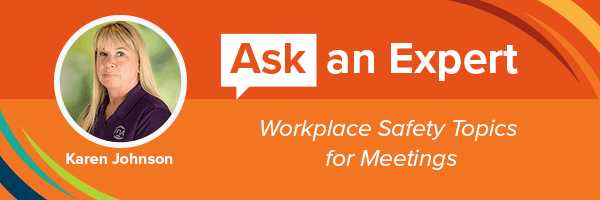
Workplace Safety Topics for Meetings
Last modified on November 22nd, 2022
Ask an Expert: Karen Johnson
Talking about Workplace Safety Topics for Meetings and Other Safety Issues
Kicking off our Ask an Expert series is Karen Johnson, the Safety Training & Resource Development Manager at FFVA Mutual. With almost 30 years of experience in the field, Karen has developed a distinct expertise in workplace safety training for personal safety. We recently sat down with Karen for a conversation covering the full range of workplace safety issues, from workplace safety topics for meetings to available occupational safety training programs.

FFVA Mutual: What are some of the costs associated with workplace injury that employers often overlook?
Karen: “The costs that employers often overlook are the ROI for the time spent in training. They’re thinking, ‘I have to send my employees to a safety talk, and that means taking them away from the job for four hours.’ They’re looking at it from a production standpoint.
But their ROI is so much greater if they do safety training with an emphasis on personal safety for their employees. They minimize downtime for production, avoid having to replace a worker due to a workplace injury, reduce the cost of their insurance premiums, and cut the cost of injuries in and of themselves. The ROI is so much higher than if they skip safety training.”
FFVA Mutual: Do they start to realize that ROI exists once an injury happens?
Karen: “When they have a major injury that impacts their bottom line, they will often make the decision to come in for training. Of course, sometimes they still need a little push, and we’ll encourage more safety training after a major injury has happened.
It’s important to say that oftentimes, employers are afraid to do training regarding injuries because they don’t want to put that in the minds of their employees. Employers sometimes take the stance that if you don’t say anything, it won’t be on employees’ minds.”
FFVA Mutual: How do employees choose which safety training topics to focus on?
Karen: “Employers will usually be reactive when they select a workplace safety topics for meetings. They’ll choose a training topic based on a recent incident involving the personal safety of an employee. That’s the wrong way to do it.
Instead, they should analyze their safety program, take a good, hard look at their business and choose topics that are relevant to their processes or operations.
If they’re stumped, they can look at the OSHA guidelines. OSHA usually recommends training programs and topics employers should have in place based on their industry. That’s always a great place to start.
When taking that route, they should analyze what’s relevant to them and implement the required training as per the federal government, and then seek to implement anything that will directly impact the personal safety of their employees.”
FFVA Mutual: Should employers consider trainings that aren’t required by the federal government?
Karen: “Yeah, there are many things employers should provide training on that aren’t necessarily listed as a requirement by the federal government. Motor vehicle safety training is one example. The government doesn’t specifically dictate workers need defensive driving training, but many employers really do require this because of the nature of their work.”
FFVA Mutual: What’s wrong with employers taking a reactive approach to safety training?
Karen: “When you ask your employees to come into a training after a major accident has happened, they’re not going to see it as a job perk or even as a positive experience. More often, they’re going to see it as punitive; that it’s something they have to sit through and get over with.
They also miss opportunities to target other safety issues and hazards if they don’t have a larger training program. Training should teach employees how to do certain elements of their job safely, going into detail around the parameters, procedures and policies that encourage injury prevention and keep them stay safe on the job. A reactive approach doesn’t do any of that.”
FFVA Mutual: What are some of the core elements of a good safety training program?
Karen: “The core element is an analysis and assessment of the core processes in your facility. Once you complete the assessment, you’re going to decide what’s required for each job and hazard. This will help you gather a list of required training and how that training should be accomplished.
Part of this will be deciding who carries out the training for each program. It’s not always going to be the same person. You need to decide who is responsible for each type of safety issue and training and make sure they have the knowledge and the skills necessary to carry out that training.”
FFVA Mutual: How do you select individuals to lead your trainings?
Karen: “That really depends on the training, but candidates need to be knowledgeable of the topic at hand, value their personal safety, and have really good communication skills. There are a lot of very knowledgeable employees out there who know how to do the job safely, but they have trouble communicating. That’s not necessarily a person you want leading that training session.
You also need them to be a safety cheerleader. You don’t want to assign someone who doesn’t have a taste for safety – someone who’s disgruntled or doesn’t really believe in your safety program yet.”
FFVA Mutual: What are some of the training methods employers can use to make safety a priority in the workplace?
Karen: “The first one is worker involvement. After you’ve completed your analysis, you need to decide which group of employees is best suited for each training type, and you need to actually ask the employees to do the training. Peer-to-peer training like this is proven to be more effective.
The company safety committee plays an important role here. It needs to decide what training should be provided and who can do it. And, actually, the safety committee itself should be taking part in training too.”
FFVA Mutual: What are some of the advantages of FFVA Mutual’s safety training programs?
Karen: “We do webcasts. What I like about our webcasts is that they’re on demand, which makes them convenient for employees. Even if they miss the live webcast and catch it later on demand, they’re still interactive. The attendee can still ask a question and that question will actually go straight to my inbox. So even though they’re not talking directly to us, they’re still able to engage with us in real time.
We also have in-person trainings. These are usually the most effective. Trainers can actually see their students and garner real interaction. Students are less likely to get distracted, and it’s a lot more engaging in person.”
FFVA Mutual: How do employers and employees benefit from a good safety training program?
Karen: “The biggest benefit of a good training program is that employees learn what they’re supposed to do to keep themselves safe. There are a lot of very skilled workers out there. The more skilled they become without safety training, the more shortcuts they’re willing to take.
So, if you’re providing your employees with training on how to do their job safely, they’re learning to do the job properly so that they can go home to their families at the end of the workday.
The benefit to the employer is the formation of a culture of safety in the workplace. If it’s done right, employers can improve their overall workplace culture, which will resolve safety issues, help improve the company’s reputation and bottom line.”
Related Resources:
- View a list of FFVA Mutual’s safety training courses available at no-cost for agency partners and policyholders.
- Get in touch for instant access to our library of safety videos, webinars and other training resources.
- Interested in more workplace safety topics for meetings? View this blog on 5 safety committee meeting topic ideas.
FROM OUR BLOG
SEE MORE POSTS
How To Conduct a Safety Audit: A Step-by-Step Guide

Behavior Based Safety: Your Guide to a Safer Workplace
![OSHA’s Most Frequently Cited Standards [infographic]](https://b1451152.smushcdn.com/1451152/wp-content/uploads/1000-x-450-for-blog-post-main-banner-1.png?lossy=1&strip=0&webp=1)
